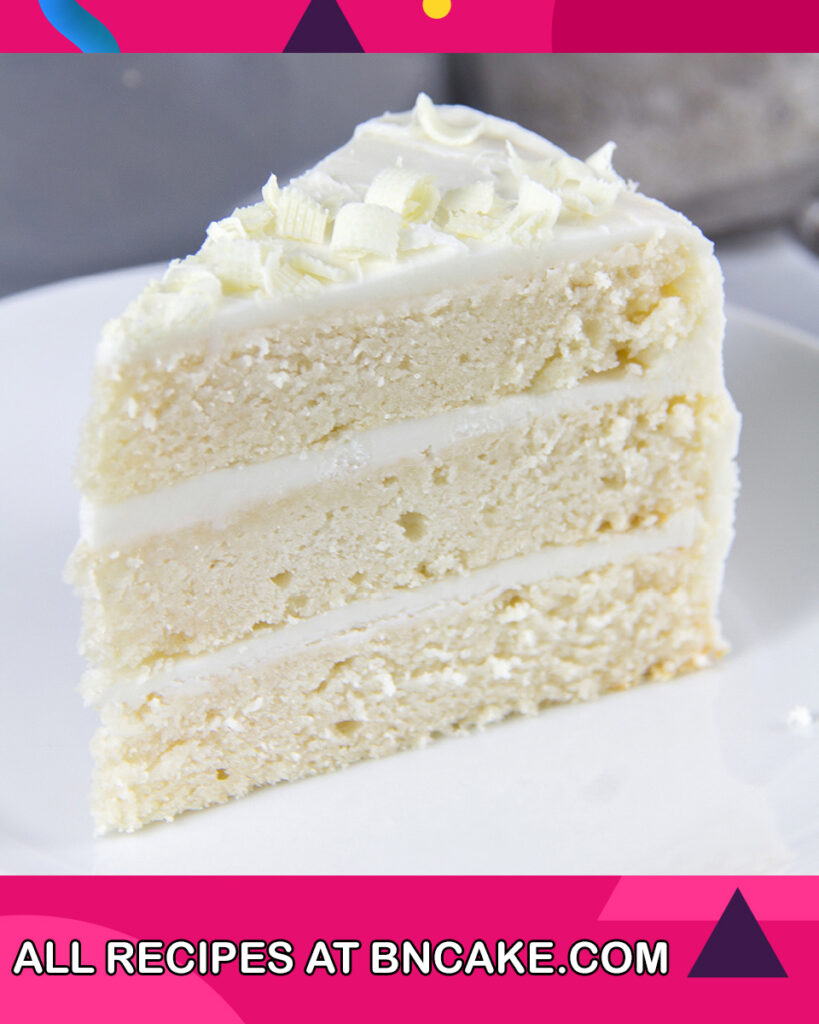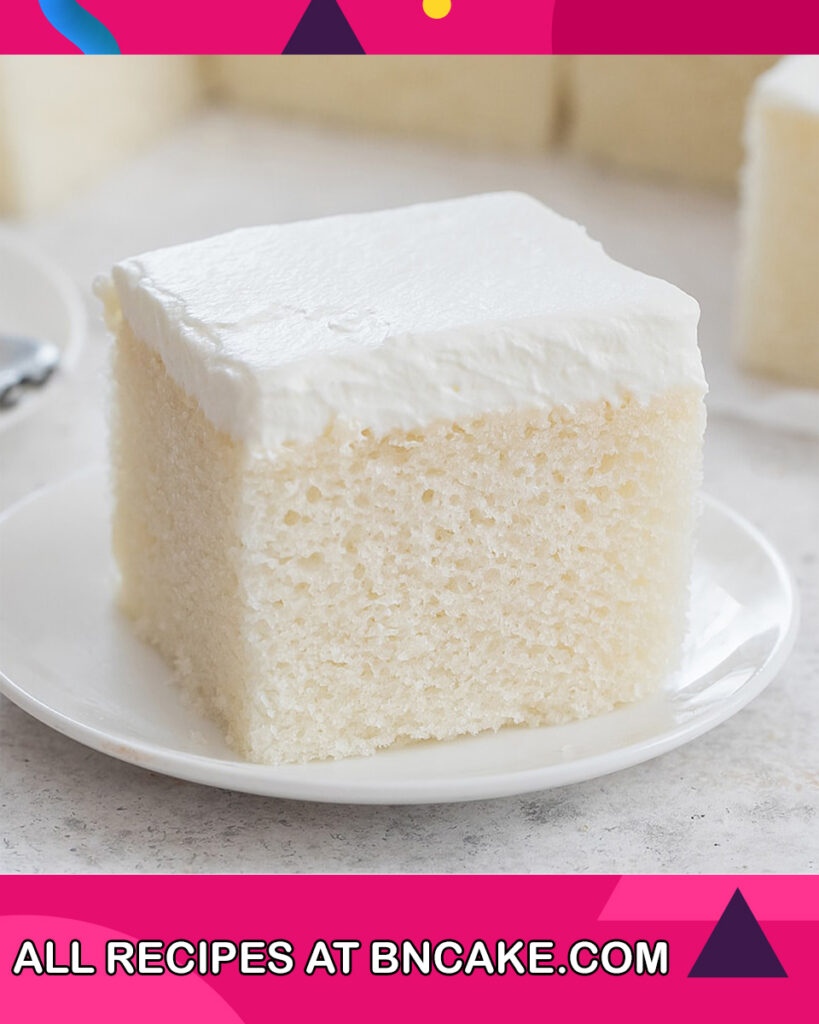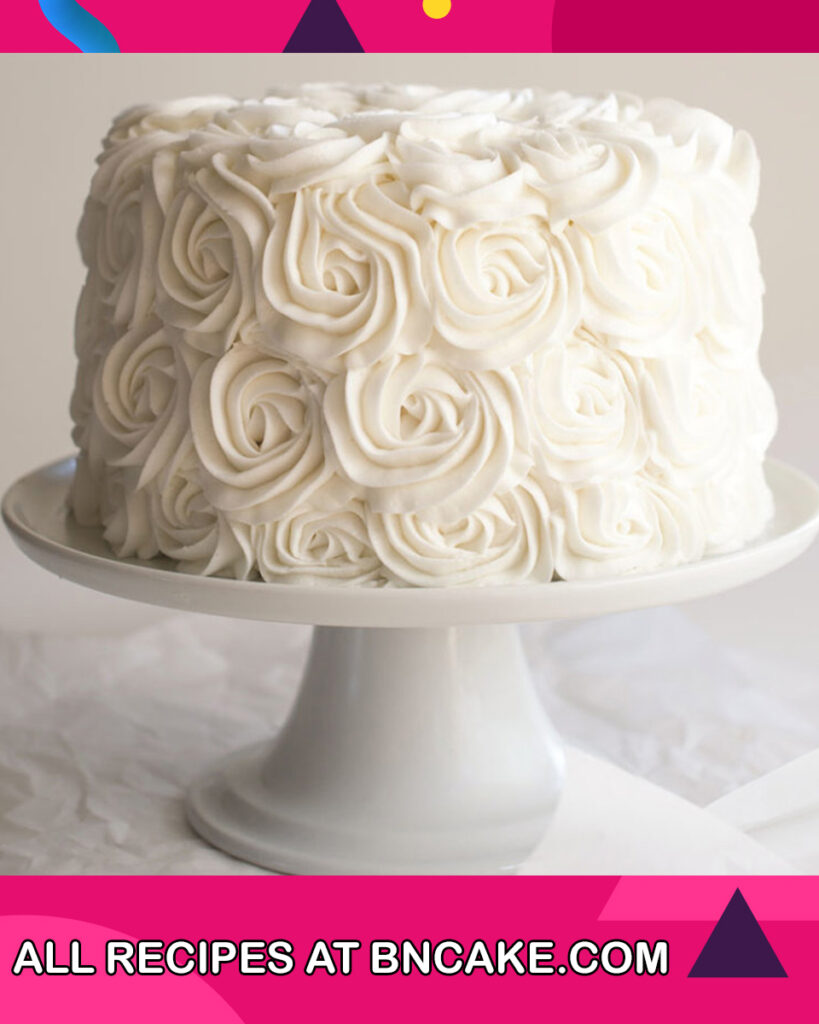White cake is a classic and timeless dessert that embodies elegance and simplicity. Known for its light and tender crumb, this cake is a canvas for various flavors and fillings. With its pristine white color, it serves as the perfect base for creative decoration, making it a popular choice for weddings, birthdays, and other special occasions. The delicate flavor of vanilla is often the star, but this versatile cake can also be infused with other extracts or additions to suit different tastes. Whether enjoyed on its own or dressed up with frostings, fruits, or other embellishments, white cake remains a beloved treat that has stood the test of time.

What Is White Cake?
White cake refers to a type of cake that is known for its pale, light-colored appearance and delicate flavor. It is typically made using a combination of simple ingredients, including flour, sugar, butter, eggs, and vanilla extract. The distinguishing feature of white cake is its tender and fine crumb texture, which gives it a soft and airy quality.
The name “white cake” comes from the cake’s characteristic color, which is often achieved by using only egg whites rather than whole eggs. This omission of egg yolks helps maintain the cake’s pale color and contributes to its light texture. While vanilla is a common flavoring in white cake, other extracts or flavorings can also be used to enhance the taste.
White cake serves as a versatile base for various fillings, frostings, and decorations. It’s frequently used in weddings and formal events due to its clean and elegant appearance. The cake’s neutral flavor and color make it an excellent canvas for a wide range of flavor combinations, allowing bakers to get creative with their choice of toppings, fillings, and frostings.
In summary, white cake is a classic dessert known for its soft texture, light color, and adaptability to different flavors and designs. It has a timeless appeal and remains a popular choice for celebrating special occasions or simply enjoying a delicious and visually appealing treat.

Why You Will Love White Cake Recipe?
- Elegance and Versatility: White cake’s pristine appearance makes it a versatile canvas for creativity. Whether you’re decorating it for a special occasion or keeping it simple, its neutral color allows for endless design possibilities.
- Delicate Flavor: The subtle flavor of vanilla in a white cake is both comforting and delicious. It’s a crowd-pleaser that appeals to a wide range of tastes.
- Tender Texture: White cake’s tender and soft crumb is a result of careful mixing and the use of egg whites. This delightful texture melts in your mouth, making each bite a pleasure.
- Customizable: While vanilla is a classic flavor, white cake can be easily adapted by using different extracts or additions. You can experiment with citrus zests, almond extract, or other flavorings to create your own unique twist.
- Perfect Pairings: White cake pairs beautifully with various fillings and frostings, from rich chocolate ganache to fruity compotes. This versatility means you can tailor it to suit your preferences or the occasion.
- Special Occasions: White cakes are often associated with celebrations like weddings and birthdays due to their elegant appearance. Baking a white cake for a significant event can add a touch of sophistication and tradition.
- Nostalgia: White cake has a timeless quality that can evoke memories of family gatherings, cozy evenings, and cherished moments. Biting into a slice of white cake can transport you to a place of comfort and happiness.
- Baking Therapy: Baking a white cake can be a rewarding and therapeutic experience. The precise measurements and steps required can help you focus and unwind while creating something beautiful and delicious.
- Impressive Yet Simple: Despite its elegant appearance, making a white cake doesn’t always require complex techniques. With the right recipe, even beginner bakers can achieve stunning results.
- Crowd-Pleasing: White cake’s mild flavor and appealing look make it a dessert that is sure to please a wide range of tastes. Whether it’s a family gathering, a potluck, or a party, a white cake is likely to be a hit.
In conclusion, a white cake recipe offers a combination of elegance, flavor, texture, and customization that makes it a delightful treat for any occasion. Its versatility and timeless charm make it a dessert that you’ll love to bake and share with others.

Ingredients For White Cake
- 2 1/2 cups all-purpose flour
- 2 1/2 teaspoons baking powder
- 1/2 teaspoon salt
- 1 1/4 cups unsalted butter, softened
- 2 cups granulated sugar
- 5 large egg whites
- 2 teaspoons vanilla extract
- 1 cup whole milk
How To Make White Cake
- Preheat the oven to 350°F (175°C). Prepare two 9-inch round cake pans by greasing and flouring or lining them with parchment paper.
- In a medium-sized bowl, combine the All-Purpose Flour (2 1/2 cups), Baking Powder (2 1/2 teaspoons), and Salt (1/2 teaspoon). Whisk together to evenly distribute the dry ingredients. Set aside.
- In a large mixing bowl, cream the Unsalted Butter (1 1/4 cups, softened) and Granulated Sugar (2 cups) together until the mixture becomes light, fluffy, and pale in color. This should take around 3-4 minutes.
- Gradually add the Large Egg Whites (5) to the butter-sugar mixture, one at a time, beating well after each addition. Scrape down the sides of the bowl to ensure even mixing.
- Mix in the Vanilla Extract (2 teaspoons) to infuse the batter with a subtle vanilla flavor.
- Alternately add portions of the dry flour mixture and the Whole Milk (1 cup) to the wet ingredients, beginning and ending with the dry ingredients. Mix each addition until just combined, being careful not to overmix.
- Divide the batter evenly between the prepared cake pans, smoothing the tops for even baking.
- Bake the cakes in the preheated oven for 25-30 minutes, or until a toothpick inserted into the center comes out clean.
- Remove the cakes from the oven and let them cool in the pans for around 10 minutes. Carefully invert the cakes onto a wire rack to cool completely.
- Once the cakes are fully cooled, you can proceed to frost and decorate them according to your preferences.
Remember to adjust baking times if needed based on your oven’s characteristics. Enjoy the delightful results of your homemade white cake!

How To Serve White Cake
- Cool and Slice: Make sure your white cake has cooled completely before slicing and serving. This ensures that the texture is set and the flavors have developed fully.
- Presentation: Place a slice of white cake on a clean and attractive dessert plate or serving dish. If you’re serving a whole cake, place it on a cake stand for an elegant presentation.
- Garnish: You can garnish each slice of white cake with a light dusting of powdered sugar for a simple and classic touch. Alternatively, you can add a dollop of whipped cream, a scoop of ice cream, or a drizzle of fruit sauce to complement the flavors.
- Fruit Toppings: Fresh berries, sliced fruits, or fruit compotes make excellent toppings for white cake. Their natural sweetness and vibrant colors can add a delightful contrast to the cake’s neutral palette.
- Sauce or Coulis: A thin fruit sauce or coulis, such as raspberry or mango, can be drizzled over the cake for extra flavor and visual appeal.
- Frosting and Fillings: If your white cake has been layered or frosted, make sure to display the layers and the frosting design. This can be a focal point of your dessert presentation.
- Pairings: White cake pairs well with a variety of beverages. Serve it with a cup of coffee, a glass of milk, tea, or even a light sparkling wine for a celebratory touch.
- Variations: If you’ve added a filling between layers or have flavored the cake with extracts, consider mentioning these variations to your guests so they can appreciate the creative twists.
- Individual Portions: For a larger gathering, consider cutting the cake into smaller, bite-sized portions or cupcakes. This makes it easier for guests to enjoy and helps control portion sizes.
- Celebrate Occasions: White cake is often associated with celebrations. If you’re serving it for a special occasion like a birthday, wedding, or anniversary, consider incorporating themed decorations or candles to enhance the festive atmosphere.
- Presentation Tips: Pay attention to the overall presentation – a well-presented cake can be a visual treat. Use complementary serving utensils, plates, and decorations that match the theme or mood of your event.
Ultimately, serving white cake is about creating an inviting and enjoyable experience for your guests. Whether it’s a simple slice with a dusting of sugar or a beautifully decorated masterpiece, white cake is a versatile dessert that can be tailored to suit various occasions and preferences.
How To Store White Cake
Properly storing white cake is important to maintain its freshness and flavor over time. Here’s how to store white cake to keep it delicious:
Short-Term Storage:
- Room Temperature: If you plan to consume the white cake within 1-2 days, you can keep it covered at room temperature in a cool and dry place. Use a cake dome or cover it with plastic wrap or aluminum foil to prevent it from drying out or absorbing odors.
Long-Term Storage:
- Refrigeration: If you need to store the white cake for a longer period, refrigeration is the best option. Wrap the cake tightly with plastic wrap to prevent moisture loss and place it in an airtight container to protect it from absorbing any fridge odors.
- Frosting Consideration: If the cake is frosted with a perishable frosting, like cream cheese or whipped cream, refrigeration is essential to keep the frosting from spoiling.
Tips for Storing White Cake:
- Avoid Air Exposure: Exposure to air can cause the cake to dry out. Always wrap the cake tightly to minimize air contact.
- Avoid Direct Light and Heat: Store the cake away from direct sunlight and heat sources, as these can cause the cake to become too warm or affect its texture.
- Use Airtight Containers: Airtight containers prevent moisture loss and help maintain the cake’s freshness. Make sure the container is clean and dry before placing the cake inside.
- Freezing: If you want to store the cake for an extended period (more than a few days), consider freezing it. Wrap the cake tightly in plastic wrap and then in aluminum foil to prevent freezer burn. Thaw the cake in the refrigerator when you’re ready to enjoy it.
- Labeling: If you’re storing multiple cakes or desserts in the same freezer or fridge, label each container with the date to keep track of freshness.
- No Refrigeration for Unfrosted Cakes: If your white cake is not frosted and contains ingredients like butter, it’s generally better to store it at room temperature, covered and sealed, to prevent the cake from becoming too firm in the refrigerator.
Remember that cake texture and flavor may change slightly during storage, especially if it’s refrigerated or frozen. To enjoy the best quality, try to consume the white cake within a reasonable timeframe, following the storage recommendations above.
If You Love This Recipe Try These Out!
Tips And Tricks For White Cake
Here are some useful tips and tricks for baking and enjoying a perfect white cake:
Baking Tips:
- Room Temperature Ingredients: Ensure that your butter, eggs, and milk are at room temperature before starting. This helps with better incorporation and smoother batter.
- Sift Dry Ingredients: Sifting the flour, baking powder, and salt together helps to eliminate lumps and evenly distribute leavening agents for a lighter texture.
- Gentle Mixing: When combining the wet and dry ingredients, mix just until everything is incorporated. Overmixing can lead to a tougher cake.
- Alternate Additions: When adding the dry ingredients and milk to the batter, do so in portions, starting and ending with the dry ingredients. This helps in maintaining the batter’s smoothness and texture.
- Beating Egg Whites: Whip the egg whites until they form stiff peaks, but be careful not to overbeat. They should be glossy and hold their shape.
- Fold Gently: When incorporating the whipped egg whites into the batter, use a gentle folding motion to avoid deflating the airiness.
- Even Baking: Make sure your oven is preheated accurately and use an oven thermometer to ensure the correct temperature. Rotate the cake pans halfway through baking for even results.
- Toothpick Test: To check if the cake is done, insert a toothpick into the center. It should come out clean or with a few moist crumbs, not wet batter.
Decorating and Serving Tips:
- Fully Cool Before Frosting: Always ensure the cakes are completely cooled before applying frosting. Warm cakes can cause the frosting to melt and slide.
- Crumb Coat: Apply a thin layer of frosting called a “crumb coat” to catch any loose crumbs. Chill the cake briefly before applying the final layer of frosting for a cleaner finish.
- Flavor Enhancements: Consider brushing the cake layers with simple syrup infused with complementary flavors before frosting. This keeps the cake moist and adds an extra layer of taste.
- Smooth Frosting: Use an offset spatula to achieve smooth and even frosting layers. A bench scraper can also help create a polished finish.
- Decorate Creatively: White cake is a versatile canvas for decorations. Consider using fresh flowers, edible pearls, colored sprinkles, or chocolate shavings to enhance its visual appeal.
- Portioning: Use a serrated knife dipped in hot water for clean slices. Wipe the knife between cuts to prevent smudging.
- Storing Decorated Cakes: If your white cake is frosted and decorated, store it in the refrigerator. Use toothpicks and plastic wrap to shield the decorations from touching the frosting.
- Flavor Infusion: Experiment with adding extracts, zests, or even a touch of food coloring to the batter to create unique variations of white cake.
By following these tips, you can ensure a successful baking experience and a delicious white cake that’s not only visually appealing but also a joy to savor.

FAQs And Troubleshooting About White Cake
FAQs:
- Can I use whole eggs instead of just egg whites in a white cake?
Yes, you can, but using only egg whites is what gives white cake its characteristic pale color. Whole eggs will add a slight yellow hue and potentially alter the texture. - Can I substitute cake flour for all-purpose flour in a white cake recipe?
Yes, you can. Cake flour will yield a softer, more delicate texture. Replace every cup of all-purpose flour with 1 cup of cake flour. - Can I make cupcakes with a white cake recipe?
Absolutely! Adjust the baking time to around 15-20 minutes for cupcakes. Use a toothpick to test for doneness. - How can I prevent my white cake from becoming dry?
Be cautious not to overbake the cake. Follow the recommended baking time and use a toothpick test. You can also brush the layers with simple syrup to keep them moist. - Can I freeze white cake?
Yes, you can freeze white cake. Wrap it well in plastic wrap and then aluminum foil to prevent freezer burn. Thaw in the refrigerator before serving.
Troubleshooting:
- Cake is too dense or heavy:
This could be due to overmixing the batter or using expired baking powder. Mix gently and ensure your baking powder is fresh. - Cake is too dry:
Overbaking is the usual culprit. Check for doneness a few minutes before the recommended baking time. You can also add a syrup soak after baking to add moisture. - Cake has a sunken center:
This can happen if the cake is underbaked or if the oven temperature is not accurate. Use an oven thermometer to check the temperature and ensure the cake is fully baked. - Cake is unevenly baked:
Uneven baking can occur if your oven’s heat distribution is uneven. Rotate the cake pans halfway through baking to help even out the results. - Cake sticks to the pan:
Grease and flour the pans properly or use parchment paper. Let the cake cool slightly before attempting to remove it from the pan. - Frosting is too soft:
If your frosting is too soft, refrigerate it for a short while to firm it up before applying it to the cake. - Frosting is too stiff:
Gradually add a small amount of milk or cream and beat to achieve the desired consistency. - Frosting has air bubbles or looks grainy:
This can happen if the powdered sugar isn’t fully incorporated. Sift the powdered sugar before using and beat the frosting until smooth.
Remember, baking is a learning process, and even experienced bakers encounter challenges. Don’t be discouraged by mishaps; they’re opportunities to refine your skills and create even better white cakes in the future!
Nutritional Information
The nutritional content of white cake can vary based on the recipe and specific ingredients used. However, I can provide you with a general idea of the approximate nutritional information for a typical slice of white cake (1/12th of a 9-inch round cake) without frosting:
Calories: Around 250-300 calories, Total Fat: Approximately 10-15 grams, Saturated Fat: Around 6-8 grams, Cholesterol: Approximately 30-40 milligrams, Sodium: Around 200-250 milligrams, Total Carbohydrates: Approximately 35-45 grams, Dietary Fiber: Around 0-1 gram, Sugars: Approximately 20-25 grams, Protein: Around 3-5 grams
Keep in mind that these values are for the cake itself, without any frosting or additional toppings. Adding frosting, fillings, or toppings will increase the overall calorie and nutrient content. If you’re looking for more specific nutritional information, it’s best to refer to the nutritional labels of the specific ingredients you’re using or use a reliable recipe calculator.





